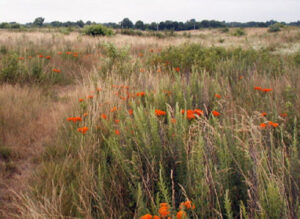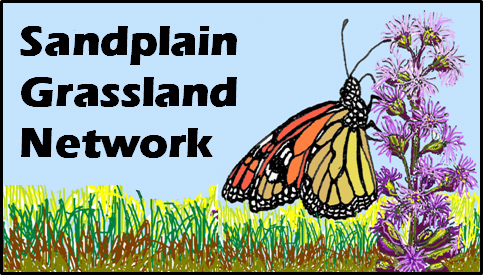Selective Vegetation Removal
Hempstead Plains is the most iconic and historic grassland of the northeast (Edinger et al 2014). A total of 24 fragmented acres (10 hectares) is all that remains of the larger grassland area that once covered about 40,000 acres in Nassau County, New York (Edinger and Young 2018). The largest continuous extant area of Hempstead Plains consists of 19 acres (8 hectares) and is located on the campus of Nassau Community College (formally Mitchel Field Air Force Base) and is managed by the Friends of Hempstead Plains at Nassau Community College (Fig. 2). This non-profit organization was established in 2001 to preserve and restore the Hempstead Plains and offer educational programs at this unique area (Gulotta 2005).

Figure 1. Hempstead Plains during the growing season. Photo: Friends of Hempstead Plains.

Figure 2. Extent of the Hempstead Plains with soils. Map credit: Carole Ryder.
In 1909, the Hempstead Plains remained largely unplowed and had a grassland community composition with a large proportion of native plants (Harper 1912). At that time, the four most abundant tree species, gray birch (Betula populifolia), blackjack oak (Quercus marilandica), post oak (Quercus stellata), and pitch pine (Pinus rigida), were stunted and scattered sparsely throughout the barren landscape (Harper 1912). In addition, a dozen shrub species, sixty herb species, and a few moss, lichen and fungi species were recorded at the time (Harper 1912). Common shrubs including scrub oak (Quercus ilicifolia) and dwarf chinquapin oak (Quercus prinoides) that grew roughly at knee height. Little bluestem (Schizachyrium scoparium) was the most common grass.
However, over time, floristic inventories document the encroachment of non-native species into the Hempstead Plains. In 1987, Lamont and Stalter observed 171 species of which 62 percent were native, while a subsequent survey in 2004 by Eric Lamont documented 185 species with only 54 percent being native (B. Gulotta, Interview). This indicates that the higher numbers of species documented in the Plains are attributed to non-native encroachment. A 2017 complete community plant survey of the Hempstead Plains, including the Purcell parcel south of the highway, conducted by New York Natural Heritage Program identified that the plains now support an estimated 294 plant species (Edinger and Young 2018). An alarming trend of invasive species encroachment was further identified by a comparison of the 1999 and 2017 community surveys, which revealed that the number of invasive species increased from six in the 1980s to 34 in 2017 (Edinger and Young 2018). Collectively, these trends identify nonnative and invasive species as a critical management challenge that threatens the ability of the Plains to provide habitat to globally- and state-rare species.

Sandplain gerardia (Agalinis acuta) is a federally endangered plant that is known from about a dozen populations in five states, with the Hempstead Plains containing the second largest population in New York (S. Sinkevich, Interview). Monitoring of sandplain gerardia in 2000, 2006 and 2007 (Fig. 4) by The Nature Conservancy showed large fluctuations in the populations throughout Long Island (M. Jordan, Interview). For example, in 2006, the average number was at 8,400 plants. In 2007, the number of plants dropped to 3,081 which was the lowest recorded since 1997. It is unclear why populations have fluctuated so drastically. The Hempstead Plains supports 13 other rare species (Table 1).

Table 1. Rare plant survey history and ranking for species documented in the Hempstead Plains (Young 2017, Edinger and Young 2018).
| Scientific Name | Common Name | Year First Surveyed | Year Last Surveyed | Heritage and Protected Rank |
| Agalinis acuta | Sandplain gerardia | 1984 | 2016 | G1S1 E |
| Aletris farinosa | Stargrass | 1990 | 2010 | G5 S2 T |
| Asclepias viridiflora | Green Milkweed | 1984 | 2010 | G5 S2 T |
| Carex mesochorea | Midland Sedge | 1985 | 1985 | G4G5 S2 T |
| Crocanthemum dumosum | Bushy Frostweed | 1983 | 2003 | G3 S2 T |
| Crocanthemum propinquum | Low Frostweed | 2010 | 2010 | G4 S2 T |
| Cuscuta pentagona | Five-angled Dodder | 1991 | 1991 | G4G5 S3 R |
| Desmodium ciliare | Hairy Small-leaved Tick-trefoil | 1991 | 1997 | G5 S2S3 T |
| Lespedeza angustifolia | Narrow-leaved Bush Clover | 1985 | 1992 | G5 S2 T |
| Polygala nuttallii | Nuttall’s Milkwort | 1985 | 1985 | G5 S2 T |
| Scleria pauciflora | Few-flowered Nut Sedge | 1983 | 1997 | G5 S1 E |
| Sericocarpus linifolius | Narrow-leaved White-topped aster | 1992 | 1997 | G5 S2 T |
| Stachys hyssopifolia var. hyssopifolia | Rough Hedge Nettle | 1984 | 1991 | G5T4T5 S2 T |
| Viola pedata | Birds-foot Violet | 1984 | 1984 | G5 S3 R |
History of Management
Management
The Friends of Hempstead Plains has been the primary manager of the Hempstead Plains since its inception in 2001. It managed the Hempstead Plains in partnership with The Nature Conservancy from 2001 to 2005. The goals of the management have been to: (1) protect endangered species, (2) remove non-native invasive plant species, (3) improve and restore native habitat and (4) decrease woody shrub growth.
Experimental Studies
Experimental Studies
Susan Antenen and Robert Zaremba of The Nature Conservancy conducted prescribed burns at Hempstead Plains from 1991 to 1995 (Antenen et al. 1991). A research study was also conducted to evaluate effects of mechanical, chemical, and fire treatments on three invasive plant species. A total of 18 10 x 10 m plots were established in 1991 and 1992 in areas of mugwort (Artemisia vulgaris), Chinese lespedeza (Lespedeza cuneata), and cypress spurge (Euphorbia cyparissias) (Jordan, et al. 2002). Treatments included: (1) mowing one to three times annually, (2) one application of the herbicide Roundup (6 oz/gal;) at 0.10 oz/m2 in 1992 or 1993, (3) one herbicide application in both 1992 and 1993, (4) prescribed burn in spring or fall in one or two years from 1991 to 1995, and (5) combination treatments of prescribed fire and herbicide application (Jordan et al. 2002). Species cover was estimated prior to mowing and herbicide for every plot in 1992 to 1995 and 2001 (Jordan et al. 2002).
Results
Results
Jordan, et al. (2002) found that mugwort was nearly eliminated by mowing two to three times per year for three years, and limited regrowth occurred after applying herbicide two years in a row. However, the abundance of mugwort remained unchanged with dormant season burns and burn-herbicide treatments. Mugwort is a clump-forming rhizomatous perennial that reproduces primarily by vegetative spread (Jordan et al. 2002). Reduction by repeated herbicide or mowing application likely occurred because of exhaustion of stored reserves in the rhizomes.
Chinese lezpedeza cover was only temporarily reduced in the mowed plots, and showed variable change in burn only plots. In plots in which burn-herbicide combination treatments were applied, Chinese lespedeza was nearly eliminated within two years, but subsequently regrew to cover levels that equaled or exceeded initial abundance. Chinese lespedeza spreads primarily by seeds, and its rapid expansion following herbicide application was likely a result of the presence of a persistent soil seedbank. Mowing was largely ineffective at controlling this species most likely because of root sprouting or recruitment from the seedbank.
Cypress spurge was present in only three plots in 1992. However, it invaded four other plots between 1992 and 1995 and increased in cover during that time. Cypress spurge appears to reproduce only vegetatively at this site, and mowing, fire and herbicide were all ineffective at its control. Removal of taller competitors by mowing or herbicide may have facilitated the dramatic increase of this species.
Copper leafy spurge flea beetles (Aphthona flava) were also introduced in some areas of Hempstead Plains in 2002 as a biocontrol effort for cypress spurge. While the beetles do not directly kill this forb, the combined effects of foraging of adult beetles and larvae on foliage in mid-June and July, and feeding on roots in the spring weaken the plants. Monitoring documented the abundance of adult beetles and a negative effect on the cypress spurge cover overtime, (B. Gulotta, Interview).
An inadvertent response to the reduced abundance of cypress spurge has been an increase in mugwort (B. Gulotta, Interview). Constant mowing seemed to weaken and reduce the abundance of mugwort. However, a 10 x 10 ft (3 x 3 m) canvas that was used to cover two mugwort patches in early spring for two to three months reduced mugwort and allowed rapid regrowth of forbs dominated by common milkweed (Asclepias syracia) and Indian hemp (Apocynum cannabinum).
Ultimately, this study found that the effects of invasive plant control at Hempstead Plains varied by species and was a function of interrelated management variables. Species reproductive attributes, growth form, and competitive ability were all important species characteristics (M. Jordan, Interview). Specifically, mugwort was eliminated by repeated mowing and herbicide. Chinese lespedeza was not affected by dormant season burning, by repeated mowing, and effects of fire varied (M. Jordan, Interview). Herbicide nearly eliminated Chinese lespedeza, but it rebounded close to its pretreatment levels within 2 to 6 years, likely from a persistent seedbank (M. Jordan, Interview). Finally, cypress spurge was not controlled by mowing, herbicide, or fire and it greatly increased in cover and extent under these treatments, because of elimination of competing species (M. Jordan, Interview).
References
References
Antenen, S., Jordan, M., Zaremba, R.E., & Motivans, K. 1991. Fire management plan: Restoration of the Hempstead Plains Nassau County, Long Island, New York. Unpublished Report to The Nature Conservancy.
Edinger, G.J., Evans, D.J., Gebauer, S., Howard, T.G., Hunt, D.M., & Olivero, A.M. 2014. Ecological communities of New York State. In A revised and expanded edition of Carol Reschke’s Ecological Communities of New York State, New York Natural Heritage Program, New York State Department of Environmental Conservation, Albany, NY.
Edinger, G.J., & Young, S.M. 2018. Hempstead Plains Grassland Ecological Community Mapping and Rare Plant Survey. New York Natural Heritage Program, Albany, NY.
Gulotta, B. 2005. Saving the prairie: The Hempstead Plains on Long Island. Long Island Botanical Society 15: 21–28.
Harper, R.M. 1912. The Hempstead Plains of Long Island. Society 12: 277–287.
Jordan, M.J., Lund, B., & Jacobs, W.A. 2002. Effects of mowing, herbicide and fire on Artemisia vulgaris, Lespedeza cuneata and Euphoria cyparissias at the Hempstead Plains grassland, Long Island, New York. Unpublished report to The Nature Conservancy, Long Island Chapter.
Young, S.M. 2017. Hempstead Plains Grassland plant list. Unpublished Excel File, New York Natural Heritage Program, Albany, NY.
Other Sources
Jordan, Marilyn. Interviewed by Lena Champlin. June 30, 2017.
Gulotta, Betsy. Interviewed by Lena Champlin. June 30, 2017.
